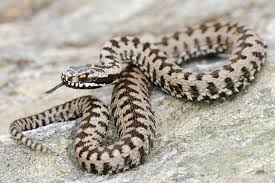A feature of these reptiles is that they have scales (or an armor). In the Netherlands and Belgium four serpentine occur:
the slow worm (Anguis fragilis) which is actually a legless lizard, not a snake;
the smooth snake (Coronella austriaca, threatened and protected),
the grass snake (Natrix natrix helvetica, vulnerable),
and the (common) adder (or viper)(Vipera berus, protected), the only poisonous, and only very rarely fatal.
A male snake has 2 (hemi) penises.
They are shy, move writhing on, have no limbs, a forked tongue to 'taste' the air, and love a moist environment with open spaces for sunbathing (because they are cold-blooded).
The harmless slow worm is usually hazel brown and up to 45 cm long. Due to the relatively small scales the body looks shiny. The tail is blunt and breaks - if you take him - off like other lizards. The females have dark flank stripes.
The tongue is forked a little. The slow worm should unlike snakes open her mouth to stick out her tongue. She has movable eyelids, snakes never have. The head of snakes is often triangular and distinct from the body.
The propelling is relatively stiff.
They occur in the Veluwe, Brabant, Limburg and Flanders. Favorite prey are snails, worms, insects and others. They have several natural enemies: (predatory) birds, cat, fox, rats, marten, badger, smooth snake, and chicken.
On the menu of our snakes are especially frogs.
The smooth snake has a fairly uniform brown to gray-brown color, dark spots rows on back and tail, an egg-shaped head with a somewhat spatula -shaped snout.
Its scales are smooth: they have no keel plates (with longitudinal seam in the middle) unlike the adder and grass snake.
It has, in contrast to the adder a yellow iris and a round pupil, no real zigzag drawing, a longer tail and a slimmer body.
You find them in heathlands in Antwerp, Limburg and Flemish Brabant.
The grass snake has a gray color, standing black rectangles along the flanks and has yellow spots behind the head. The grass snake has a more yellow eye color and a clear round pupil.
The male is 80 to 100 cm, the female 90 to 140 cm.
Since 2017, our 'Grass Snake' (Natrix natrix) is a separate neighbor of the Barred Grass Snake' (Natrix helvetica, Eastern Europe, Balkan) due to substantial genetic differences.
 The adder or viper is about 50 to 70 cm long and can be recognized by the cupper brown to red-eye with vertical pupil, what protruded scale above the eye and the zigzag pattern on the back. The toxicity is often overestimated, a bite is rarely fatal.
The adder or viper is about 50 to 70 cm long and can be recognized by the cupper brown to red-eye with vertical pupil, what protruded scale above the eye and the zigzag pattern on the back. The toxicity is often overestimated, a bite is rarely fatal.
In Belgium, the viper is rare to find between the Sambre and Meuse in the west of the Ardennes, and near the Antwerp Kempen. In the Netherlands you see them in Drenthe, Friesland, Gelderland and Limburg. Areas with plenty of hiding places: dense vegetation, rocks or caves.
The Taiwanese rat snake is yellow - golden brown with a pattern of black spots. Rear she has two black and one yellow stripe. The head is gray with blue and she has a blue tongue. She is on average between 1.2 and 1.8 meters and is not toxic.
The snakes can survive our winters. In Belgium Kuringen in 2016 eggs were found of this species.
This is the first evidence that the species also reproduces here.
Eating snake
In Thailand I've eaten two kinds of snake. I do not remember which. There was little meat, but it was quite tasty.
In the countries of the Caucasus snake is on the menu. In northwestern Armenia ‘Byrkbigm ‘ is a popular dish. Head, bones, organs and skin are removed. The meat is cooked in about four hours in herbal water (with thyme and bay leaf). Often after three hours potatoes and carrots are added. In combination with the byrkbigm they like drinking brandy (the national drink in Armenia).
Snake: "Are we poisonous?" Other: "Why?"
"Because I have bitten my tongue."
